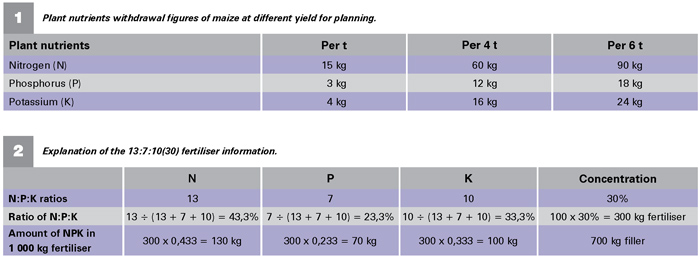July 2021
| PIETMAN BOTHA, INDEPENDENT AGRI- CULTURAL CONSULTANT |
 |
The performance and yield of a maize crop is directly related to the climate soil and fertilisation. Soil test results are needed in order to determine the nutrient requirements and the correct application thereof.
WHAT MAIZE NEEDS FOR EFFECTIVE GROWTH
For optimal yield, it is essential that the maize plant grows rapidly once the germination is complete. In order for rapid growth to take place, the required amount of nutrients need to be available. Maize needs nitrogen (N), phosphorus (P) and potassium (K) for effective growth and crop yield. These nutrients are essential for grain production and do not usually occur in sufficient quantities in the soil.
CHOOSING FERTILISER
In cases where there are no soil test results available and you don’t have a fertiliser representative to guide you, the Fertiliser Association of Southern Africa (FERTASA) regularly publish the fertiliser withdrawal figures per crop. See Table 1 for the plant nutrients withdrawal figures of maize. This table is a broad guideline and does not take into account aspects like denitrification and phosphate fixation. It is not the best way to determine the fertiliser programme, only a guideline. Rather consult an expert for an optimal fertiliser programme.
There are a number of different types of fertilisers available, for example 13:7:10(30), 15:8:4(27), 20:7:3(30) and urea (46:0:0) more. The question is which one will suit your requirement.
It is important to understand what the meaning of the numbers on the fertiliser bag is. Let us for example take the 13:7:10(30). The first three numbers are always the ratio between N:P:K in that order. The number in the bracket is the concentration of the ingredient in the bag. In this case it means that only 30% of the bag is fertiliser. The rest is a filler to bind the ingredients together. Table 2 is an explanation of the information in the 13:7:10(30) as an example.

In the decision what fertiliser to apply, it is important to calculate the P:K ratio needed as well as the P:K ratio of the fertiliser. In Table 1, in the case of the 4 ton yield information, 60:12:16 the P:K ratio is 75% (12 ÷ 16) and the ratio of the 13:7:10(30) fertiliser the ratio is 70% (7 ÷ 10). The 15:8:4(27) the P:K ratio is 200% (8/4). If only these two fertilisers are available the 13:7:10(30) will be the best option.
To decide how much fertiliser to apply we know that we need 16 kg potassium. In total 160 kg 13:7:10(30) is needed. To calculate this 16 ÷ concentration ÷ K ratio in the fertiliser. In this case 16 ÷ 30% ÷ 33.3% = 160 kg fertiliser per hectare.
With the application of 160 kg 13:7:10(30) fertiliser there will be 20,78 kg nitrogen 11,18 kg phosphorus and 16 kg potassium applied. It is clear that there is a shortage of 39,22 kg N. This nitrogen shortage can be corrected with a topdressing application which can be done by applying 85 kg urea. By doing it this way the fertiliser needed to be applied can be calculated.
Publication: July 2021
Section: Pula/Imvula